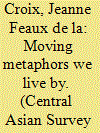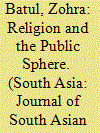| Srl | Item |
| 1 |
ID:
107546


|
|
|
|
|
| Publication |
2011.
|
| Summary/Abstract |
Based on anthropological fieldwork between 2006 and 2008, this article compares how people in the Toktogul region of Kyrgyzstan understand and interact with water in three highly significant places: mountain pastures (jailoos), the Toktogul hydroelectric dam that controls the flow of the Naryn and sacred sites (mazars). Sidelining the vast standing waters of Toktogul Reservoir, valley residents instead highlight the positive qualities of flowing water at mazars, pastures and the working dam. Contrasting how metaphors of running water are put to use conceptually by Toktogul residents and social scientists opens up a critique of current academic and policy-oriented descriptions of the world as 'flow'. Attention to a particular kind of movement (flowing water) highlights some of the silent assumptions in current depictions of a mobile world 'in flux'.
|
|
|
|
|
|
|
|
|
|
|
|
|
|
|
|
| 2 |
ID:
188743


|
|
|
|
|
| Summary/Abstract |
The engagement of religion in political movements adds credibility to the struggle and commands participation that is difficult for believers to disregard. The political leaders in the Kashmir Valley, from a range of positions, have gained legitimacy by linking their political movements to Islam and its icons, such as shrines and mosques, particularly in the early twentieth century. Owing to the enduring conflict in Kashmir and limited spatial availability for dissent, sacred spaces have emerged as the predominant sites of political mobilisation. By employing ethnographic research and critical discourse analysis, this study demonstrates that mosques and shrines play a notable role in Kashmir’s politics, facilitating the articulation of an oppositional discourse to the statist narrative. The article further states that the use of sacred sites and other religious symbols has favoured an Islamic framework in the conflict politics of Kashmir; nevertheless, it is not essentially an Islamic movement in terms of its goals and convictions. These concerns are explored in congruence with the ways in which religious nationalisms intersect with political movements in the public sphere of non-Western societies.
|
|
|
|
|
|
|
|
|
|
|
|
|
|
|
|